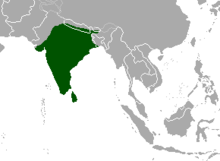| Chital | |
|---|---|

| |
| Stag | |

| |
| Doe Both in Kanha National Park in Madhya Pradesh | |
| Scientific classification | |
| Domain: | Eukaryota |
| Kingdom: | Animalia |
| Phylum: | Chordata |
| Class: | Mammalia |
| Order: | Artiodactyla |
| Family: | Cervidae |
| Genus: | Axis |
| Species: | A. axis
|
| Binomial name | |
| Axis axis (Erxleben, 1777)
| |

| |
| Distribution of chital (2011)[2] | |
| Synonyms[3][4] | |
|
List
| |
The chital or cheetal (Axis axis; /tʃiːtəl/), also known as the spotted deer, chital deer and axis deer, is a deer species native to the Indian subcontinent. It was first described and given a binomial name by German naturalist Johann Christian Polycarp Erxleben in 1777. A moderate-sized deer, male chital reach 90 cm (35 in) and females 70 cm (28 in) at the shoulder. While males weigh 70–90 kg (150–200 lb), females weigh around 40–60 kg (88–132 lb). It is sexually dimorphic; males are larger than females, and antlers are present only on males. The upper parts are golden to rufous, completely covered in white spots. The abdomen, rump, throat, insides of legs, ears, and tail are all white. The antlers, three-pronged, are nearly 1 m (3 ft 3 in) long.
- ^ Cite error: The named reference
Suraprasit2016was invoked but never defined (see the help page). - ^ a b Duckworth, J.W.; Kumar, N.S.; Anwarul Islam, M.; Sagar Baral, H. & Timmins, R. (2015). "Axis axis". IUCN Red List of Threatened Species. 2015: e.T41783A22158006. doi:10.2305/IUCN.UK.2015-4.RLTS.T41783A22158006.en. Retrieved 19 November 2021.
- ^ Srinivasulu, C.; Srinivasulu, B. (2012). South Asian Mammals: their Diversity, Distribution, and Status. New York: Springer. pp. 357–358. ISBN 978-1-4614-3449-8.
- ^ Cite error: The named reference
MSW3was invoked but never defined (see the help page).
